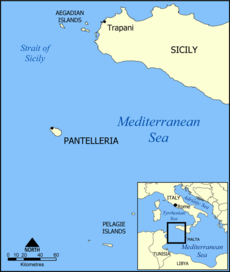Pantelleria *
 Pantelleria was formed by ancient volcanic action, but even as recently as 1891 there was a submarine eruption off its NW coast. This ancient vulcanism created large deposits of highly-prized obsidian on the island. Because of its importance for tool making, it was traded extensively in the Central Mediterranean from the Neolithic period onwards(g).
Pantelleria was formed by ancient volcanic action, but even as recently as 1891 there was a submarine eruption off its NW coast. This ancient vulcanism created large deposits of highly-prized obsidian on the island. Because of its importance for tool making, it was traded extensively in the Central Mediterranean from the Neolithic period onwards(g).
The island, formerly known as Cossyra, is an Italian-controlled island between Sicily and Tunisia. One suggestion, from Andis Kaulins has been that it was the original Gaderia(a).
This conclusion is probably based on the existence of a location on the northeast coast of the island called Gadir. However, it must be kept in mind that Gadira or variants of it are frequently found in the Mediterranean region, usually at the site of former Phoenician settlements. However, north of Pantelleria is the Egadi Islands(c), another name evocative of Plato’s Gades.
Gades has been associated with Erytheia in the story of the Trials of Hercules, so if the Map Mistress website is correct in locating Erytheia(d) between Pantelleria and the Egadi Islands, it would confine all the ‘Trials’ in the Central and Eastern Mediterranean, consequently, locating the Pillars of Heracles somewhere in the latter region.
More recently, some authors have identified the Straits of Sicily as being the location of the Pillars of Heracles referred to by Plato in his tale of Atlantis. A land bridge between Sicily and Tunisia, including Pantelleria, has also been suggested, but this is unlikely according to bathymetric data.
Novelist Samuel Butler (1835-1902) identified Pantelleria as Calypso’s Island, but the idea received little support(i).
A fortified Neolithic village has been unearthed on its west coast and ancient structures, known as ‘sesi’, similar to the nuraghi of Sardinia, are to be seen in the southeast. One in particular, known as the Grande Sese, is a 5,000-year-old six-metre high mausoleum, containing twelve ‘cells’. “The civilization who built this and another sese nearby are believed to have settled on the island after arriving from Northern Africa.”(h)
In 2005, jewellery in the style of the Egyptian Second Intermediate Period (1700-1550 BC) was discovered on the island. This would add to the opinion that Pantelleria was a major trading and cultural crossroads in ancient times.
Massimo Rapisarda has commented that “a good candidate to host a primordial civilization might have been the archipelago then existing in the Strait of Sicily, a natural maritime link between Tunisia and Italy, prized by the presence of an obsidian source at Pantelleria.”(f)
In August 2015, it was claimed(b) that a manufactured stone column was found on the Pantelleria Vecchia Bank, just north of the island of Pantelleria, in 40 metres of water. It is claimed that the area was formerly the site of an archipelago, if not actually connected to Sicily before the last Ice Age ended around 7350 BC. The monolith was dated using shells extracted from it. It took no time before the discovery was linked by a number of sites with Plato’s Atlantis. While I believe that the area was part of the Atlantean domain, I am more inclined to date its expansionist intentions to a much later period, such as the 2nd millennium BC.
(a) https://web.archive.org/web/20200130221548/http://www.lexiline.com/lexiline/lexi60.htm
(c) https://web.archive.org/web/20180627052748/http://www.mapmistress.com/egadi-islands-marettimo-levanzo-favignana.html (text only)
(d) https://web.archive.org/web/20180831115550/http://www.mapmistress.com/pantelleria-erytheia-sicily-tunisia.html (text only)
(e) Stone Pages Archaeo News: Ancient Egypt gems on Italian isle (archive.org)*
(f) https://cab.unime.it/journals/index.php/AAPP/article/view/AAPP.932C1
(g) https://www.academia.edu/33910010/Characterization_of_obsidian_sources_in_Pantelleria_Italy
(h) https://www.atlasobscura.com/places/sese-grande
(i) https://www.joh.cam.ac.uk/snap-shots-samuel-butler-esq-1893-94
